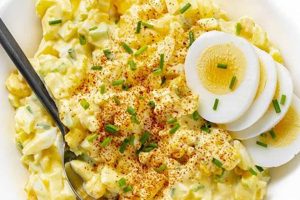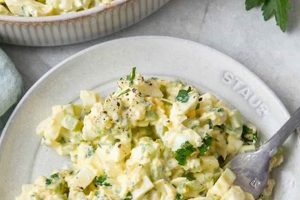A foundational culinary preparation involves combining cooked, chopped eggs with mayonnaise and seasonings. A simple version often includes celery, onion, salt, and pepper, while variations can incorporate mustard, paprika, relish, or fresh herbs. This mixture, typically served cold, can be enjoyed as a sandwich filling, a salad topping, or a standalone dish.
This dish provides a readily available source of protein and essential nutrients. Its adaptability makes it suitable for various dietary preferences, with options for low-fat mayonnaise, vegan alternatives, or the addition of nutrient-rich vegetables. Historically, variations of combined eggs and dressings have appeared in cookbooks dating back centuries, solidifying its place as a convenient and customizable meal option.
Further exploration will delve into specific ingredient choices, preparation techniques, variations, and serving suggestions to elevate this simple dish from basic to extraordinary.
Tips for Perfect Egg Salad
Achieving optimal flavor and texture requires attention to detail throughout the preparation process. These tips offer guidance for creating a superior culinary experience.
Tip 1: Perfect Egg Cooking: Overcooked yolks result in a dry, crumbly texture. Aim for a firm, yet creamy yolk by cooking eggs in simmering water for 8-10 minutes, followed by immediate immersion in ice water to halt the cooking process.
Tip 2: Chopping Consistency: Uniformly chopped eggs ensure even distribution of flavor and a pleasant mouthfeel. A sharp knife or an egg slicer facilitates consistent chopping.
Tip 3: Mayonnaise Selection: The quality of mayonnaise significantly impacts the final product. Full-fat mayonnaise yields a richer, creamier result, while low-fat or vegan alternatives cater to specific dietary preferences. Start with a small amount and adjust according to desired consistency.
Tip 4: Seasoning Balance: Proper seasoning enhances the natural flavors. Salt and pepper are essential, while paprika, mustard powder, or a dash of hot sauce add complexity. Taste and adjust seasonings gradually.
Tip 5: Fresh Ingredient Incorporation: Fresh herbs and vegetables elevate the flavor profile. Finely diced celery, red onion, or chives provide a crisp counterpoint to the creamy base. Dill, parsley, or tarragon offer aromatic complexity.
Tip 6: Chilling Time: Allowing the mixture to chill for at least 30 minutes before serving allows the flavors to meld and enhances the overall experience.
Tip 7: Serving Considerations: This versatile dish can be enjoyed in various ways. Classic sandwich fillings, lettuce wraps, or crackers provide a satisfying base. Garnishing with fresh herbs or a sprinkle of paprika enhances visual appeal.
By following these guidelines, one can consistently achieve a delicious and well-balanced result. Careful attention to detail elevates this seemingly simple dish into a truly satisfying culinary creation.
From classic preparations to innovative variations, the possibilities are endless. The following section explores diverse approaches to customize and enhance the basic recipe.
1. Hard-cooked Eggs
Hard-cooked eggs constitute the foundational ingredient. Without properly prepared hard-cooked eggs, the desired texture and flavor profile cannot be achieved. The cooking process dictates the final consistency of the yolk, influencing the overall creaminess and binding properties within the mixture. Overcooked yolks lead to a dry, crumbly texture, while undercooked yolks create an unappetizing, runny consistency. Achieving a firm yet yielding yolk is essential for optimal results. For instance, a classic egg salad sandwich requires a smooth, spreadable filling, achievable only with properly cooked eggs.
The quality of hard-cooked eggs directly impacts the success of the recipe. Factors such as cooking time, cooling method, and freshness contribute to the final outcome. Precise timing prevents rubbery or chalky textures. Rapid cooling, often achieved by plunging the cooked eggs into ice water, halts the cooking process and prevents the formation of a greenish ring around the yolk. Fresh eggs exhibit superior binding properties, contributing to a cohesive mixture. Practical application of these principles ensures a desirable final product. Consider the difference between a restaurant-quality egg salad and a hastily prepared version; the attention to detail in preparing the eggs is often a distinguishing factor.
Mastery of hard-cooked egg preparation is paramount to achieving a desirable outcome. This understanding allows for manipulation of texture and consistency, enabling adaptation of the recipe to diverse applications, from classic sandwiches to elegant appetizers. Challenges may arise from variations in egg size and cooking equipment, necessitating adjustments in cooking time. However, adherence to established principles and attention to detail consistently yields favorable results, highlighting the crucial role of hard-cooked eggs in creating a successful egg salad.
2. Mayonnaise
Mayonnaise serves as the binding agent and textural foundation of egg salad. Its emulsification of oil and egg yolks creates a creamy consistency that coats the chopped eggs, unifying the ingredients and providing a smooth mouthfeel. The quality and type of mayonnaise directly influence the overall flavor profile and richness of the egg salad. For example, using a high-quality mayonnaise with a balanced tang can elevate the dish, while a low-fat alternative might result in a less creamy, less flavorful outcome. The quantity of mayonnaise also plays a crucial role; too little results in a dry, crumbly mixture, while too much creates an overly rich, heavy texture.
The interaction between mayonnaise and other ingredients contributes to the overall balance and complexity of the egg salad. The richness of the mayonnaise complements the savory notes of the eggs and provides a backdrop for the other seasonings and mix-ins. For instance, the sharpness of Dijon mustard or the sweetness of relish is balanced by the creamy neutrality of the mayonnaise. Furthermore, the mayonnaise helps to distribute the flavors evenly throughout the mixture, ensuring a consistent taste in every bite. Understanding this interplay allows for strategic ingredient selection and precise adjustments to achieve the desired flavor profile.
Successful egg salad hinges on the judicious selection and application of mayonnaise. Careful consideration of the type, quality, and quantity of mayonnaise ensures a harmonious balance of flavor and texture. Challenges can arise from separating or thinning of the mayonnaise if introduced to excessive heat or acidity. However, adherence to best practices, such as using high-quality ingredients and maintaining appropriate temperature control, allows mayonnaise to perform its essential function in creating a well-balanced and satisfying egg salad.
3. Seasoning
Seasoning forms an integral part of the basic egg salad recipe, significantly influencing the final flavor profile. Beyond the foundational salt and pepper, judicious use of seasonings elevates the dish from simple to complex. The interplay of seasonings with the inherent richness of mayonnaise and the savory base of hard-cooked eggs creates a balanced and nuanced flavor experience. For example, a dash of paprika adds a subtle smokiness, while a pinch of cayenne pepper introduces a touch of heat. The addition of dried herbs, such as dill or chives, imparts an aromatic complexity, while a squeeze of lemon juice provides a bright, acidic counterpoint to the richness of the mayonnaise.
The transformative power of seasoning lies in its ability to enhance and balance existing flavors while introducing new dimensions. Consider the difference between an egg salad seasoned solely with salt and pepper versus one that incorporates Dijon mustard for tang, smoked paprika for depth, and fresh dill for herbaceousness. The latter offers a more complex and satisfying flavor profile, demonstrating the practical significance of thoughtful seasoning. Furthermore, the choice of seasonings can be tailored to individual preferences and dietary restrictions, allowing for endless customization. Substituting fresh herbs for dried, or adjusting the amount of salt, allows for precise control over the final outcome.
Mastery of seasoning within the context of a basic egg salad recipe allows for the creation of a dish that transcends its simple components. While challenges may arise from over-seasoning or improper balancing of flavors, careful consideration of the interplay between ingredients and seasonings allows for consistent success. Ultimately, the thoughtful application of seasoning elevates the egg salad from a basic preparation to a culinary expression, showcasing the transformative power of flavor.
4. Mix-ins
Mix-ins represent a pivotal element within the basic egg salad recipe, offering opportunities for customization and flavor enhancement. They introduce textural contrasts and nuanced flavor dimensions, transforming a simple base into a multifaceted culinary creation. Understanding the role and impact of various mix-ins allows for strategic ingredient selection, catering to individual preferences and dietary needs.
- Textural Variety
Mix-ins contribute significantly to the textural complexity of egg salad. Finely diced celery and red onion provide a satisfying crunch, contrasting with the creamy base of mayonnaise and egg. Chopped pickles or relish introduce a tangy, acidic element alongside textural variation. The interplay of these textures elevates the eating experience, moving beyond a homogenous consistency. For instance, the crispness of water chestnuts offers a distinct contrast to the softness of the eggs, creating a more dynamic mouthfeel.
- Flavor Enhancement
Mix-ins provide opportunities to enhance and personalize the flavor profile. Fresh herbs, such as dill, chives, or parsley, introduce bright, aromatic notes. Spices like paprika or curry powder add depth and complexity. Incorporating ingredients like chopped olives or capers introduces a briny, salty element. Consider the impact of smoked paprika on the overall flavor profile; it imparts a subtle smokiness that complements the richness of the mayonnaise and the savory notes of the egg. Such additions transform a basic egg salad into a more nuanced and flavorful dish.
- Nutritional Enrichment
Mix-ins can contribute to the nutritional value of egg salad. Incorporating chopped vegetables, such as bell peppers, spinach, or avocado, increases the vitamin and mineral content. Adding ingredients like chopped walnuts or sunflower seeds introduces healthy fats and protein. Consider the addition of chopped broccoli florets; they contribute fiber and vitamins while adding a subtle vegetal flavor and textural variation. Such additions transform the dish into a more nutrient-rich meal option.
- Visual Appeal
Mix-ins enhance the visual appeal of egg salad, transforming it from a monochromatic mixture into a more vibrant and appetizing dish. Brightly colored ingredients, such as red onion, chopped bell peppers, or fresh herbs, provide visual interest. The strategic placement of these mix-ins, whether dispersed throughout the mixture or used as a garnish, enhances the presentation. For example, a sprinkle of chopped fresh parsley or paprika adds a pop of color, making the egg salad more visually appealing.
The strategic incorporation of mix-ins elevates the basic egg salad recipe, demonstrating the transformative power of thoughtful ingredient selection. From enhancing texture and flavor to boosting nutritional value and visual appeal, mix-ins play a crucial role in creating a well-rounded and satisfying culinary experience. The versatility of egg salad allows for endless experimentation and customization, limited only by culinary imagination.
5. Chilling
Chilling constitutes a crucial step in the preparation of egg salad, significantly impacting both flavor development and food safety. Lowering the temperature of the mixture allows the individual flavors of the componentseggs, mayonnaise, seasonings, and mix-insto meld and harmonize. This integration of flavors results in a more cohesive and balanced final product. Furthermore, chilling inhibits bacterial growth, a critical consideration for food safety, particularly given the perishable nature of eggs and mayonnaise. An egg salad left unrefrigerated for an extended period, especially in warm environments, presents a significant risk of bacterial contamination, potentially leading to foodborne illness.
The practical implications of chilling are evident in the discernible difference between freshly made, chilled egg salad and one left at room temperature. The chilled version exhibits a more pronounced and unified flavor profile, with the individual components contributing harmoniously to the overall taste. The texture also benefits from chilling; the mixture becomes firmer and more cohesive, facilitating easier spreading or shaping. Conversely, unchilled egg salad often presents a less developed flavor profile, with the individual ingredients tasting somewhat disjointed. The texture may also be less desirable, tending towards runny or loose. These observations underscore the practical significance of chilling in optimizing both flavor and texture.
Chilling, while seemingly a simple step, plays a vital role in ensuring both the palatability and safety of egg salad. Neglecting this step compromises both the culinary experience and consumer well-being. Challenges can arise from inadequate chilling time or temperature fluctuations, potentially affecting flavor development and increasing spoilage risk. However, adherence to established food safety guidelines, such as refrigerating the egg salad promptly and maintaining a consistent cold temperature, mitigates these risks and ensures a safe and satisfying culinary outcome. This understanding underscores the integral role of chilling within the basic egg salad recipe.
Frequently Asked Questions
This section addresses common inquiries regarding the preparation and consumption of egg salad, providing clear and concise information to ensure optimal results and address potential concerns.
Question 1: How long can egg salad be safely stored?
Properly stored egg salad, kept in an airtight container within a refrigerator maintained at 40F (4C) or below, should be consumed within 3 to 5 days. Beyond this timeframe, the risk of bacterial growth increases significantly.
Question 2: Can egg salad be frozen?
Freezing egg salad is not recommended. The mayonnaise base separates upon thawing, resulting in an undesirable texture and compromised flavor profile.
Question 3: What are common signs of spoiled egg salad?
Indicators of spoilage include a sour odor, a slimy texture, or discoloration. If any of these signs are present, the egg salad should be discarded immediately.
Question 4: How can one achieve a creamier texture?
Creamier texture can be achieved by using full-fat mayonnaise, adding a small amount of mashed avocado or Greek yogurt, or ensuring the yolks are cooked to a firm yet creamy consistency, avoiding overcooking.
Question 5: What are suitable alternatives to traditional mayonnaise?
Alternatives include plain Greek yogurt, mashed avocado, or commercially available vegan mayonnaise substitutes. These options cater to various dietary preferences while providing a creamy base.
Question 6: How can one reduce the sodium content?
Sodium content can be minimized by using low-sodium mayonnaise, omitting added salt, and opting for fresh herbs and spices instead of salt-based seasoning blends.
Addressing these common questions promotes safe handling and preparation, ensuring a positive culinary experience. Understanding these aspects contributes to informed choices regarding ingredient selection, storage practices, and flavor customization.
Beyond these frequently asked questions, the subsequent section delves further into advanced techniques and variations, providing resources for culinary exploration and personalized recipe development.
Conclusion
This exploration of the foundational elements of egg salad preparation has highlighted the critical interplay of ingredients, techniques, and considerations that contribute to a successful outcome. From the precise cooking of eggs to the judicious selection of mayonnaise, seasonings, and mix-ins, each component plays a crucial role in achieving the desired flavor profile, texture, and overall quality. Proper chilling practices ensure both food safety and optimal flavor development, while an understanding of potential variations allows for customization and adaptation to individual preferences and dietary needs.
Mastery of the basic egg salad recipe provides a culinary foundation upon which endless variations and innovations can be built. This seemingly simple dish offers a canvas for culinary creativity, allowing for exploration and personalization. Continual refinement of technique and exploration of flavor combinations promise a consistently rewarding culinary experience, transforming a basic staple into a personalized expression of culinary artistry.






